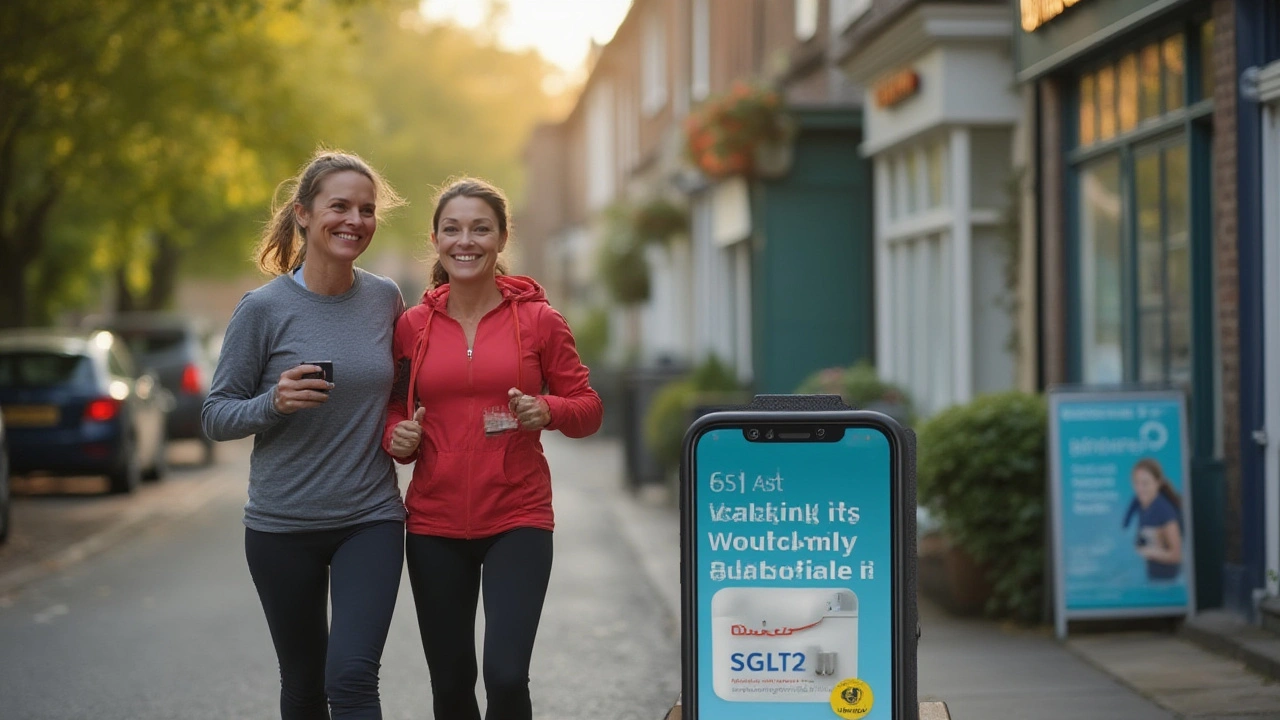The world of type 2 diabetes treatment in 2025 looks nothing like it did even a decade ago. Imagine your doctor’s office, once full of identical advice about starting metformin, now overflowing with choices, from injectables to pills, even personalized daily habits. Some people are even skipping meds (with doctor’s blessing) thanks to new tech and community trends. The big question: Is there really a better first step than metformin? Or is the 60-year-old workhorse just getting pushed aside for newer, shinier meds?
GLP-1 Receptor Agonists: Changing the Game in Diabetes Care
Let’s talk about GLP-1 receptor agonists—these meds are everywhere, not just in diabetes clinics, but making headlines for weight loss too. Drugs like semaglutide (Ozempic, Wegovy), liraglutide (Victoza, Saxenda), and dulaglutide (Trulicity) are now so popular that pharmacies have trouble keeping them stocked. But what’s all the fuss about?
GLP-1s work by mimicking a hormone that tells your body to produce more insulin after a meal, while also slowing down your stomach—so you feel fuller, longer. That “full” feeling isn’t just good for managing weight; it also blunts those dangerous blood sugar spikes after a carb-heavy meal. New studies (think: over 17,000 patients in the 2023 SELECT trial) show that these medications don’t just drop your blood sugar, they also lower your risks of heart attacks and strokes—benefits metformin has only hinted at.
Now, there’s the big issue: cost. Back in 2023, you’d pay $900 a month without insurance—unthinkable for most. By 2025, more generic versions are on the way, but insurance still decides who qualifies and who doesn’t. Want one tip? Ask your doctor whether you really meet the strict “weight and heart risk” rules. Sometimes someone with just “pre-diabetes” can get it covered, depending on insurance language.
How do people feel on GLP-1s? Real talk: you might have side effects, especially at the start. Nausea, bloating, even throwing up if you’re not careful with greasy meals. Usually, these fade, but for some, it’s a deal-breaker. The silver lining? Lots of people see an appetite drop, effortless weight loss, and more predictable blood sugars. For busy folks who can’t remember a daily pill, weekly injections mean you only have to think about it once every seven days. Honestly, that frees up brain space for enjoying life rather than obsessing over meals and meds.
Doctors are getting creative, combining GLP-1s with SGLT2 inhibitors (more on those soon) for even better blood sugar control. This “cocktail” approach is getting praise from diabetes organizations worldwide. Check the chart below for a quick comparison:
| GLP-1 Agonists | Metformin |
|---|---|
| Weekly injection (or daily pill) | Daily pill |
| Weight loss: 5-15% | Weight neutral or light loss |
| Strong heart protection | Possible heart benefit |
| Costly, but generics coming | Cheap generic |
| Side effects: mostly gut-related | Possible loose stool |
It sounds like magic, but GLP-1s aren’t for everyone. If you’ve had medullary thyroid cancer or certain pancreatic issues, skip this class. And you still can’t ignore healthy eating. If you want to see other metformin alternatives, especially for people who don’t like needles, there are choices—just keep reading.

SGLT2 Inhibitors: More Than Just Blood Sugar Pills
SGLT2 inhibitors—don’t worry about the mouthful—include meds like empagliflozin (Jardiance), dapagliflozin (Farxiga), and canagliflozin (Invokana). These drugs help your kidneys dump extra glucose into your urine, rather than letting it stick around in your bloodstream. What makes them stand out from metformin? They don’t just lower A1c by about 1%—they also drop your blood pressure, help you lose a few pounds (usually 4-7lbs), and, most impressively, protect your heart and kidneys.
If you know anyone with type 2 diabetes and heart failure or kidney disease, odds are their doctor is pushing for an SGLT2 inhibitor. Since the big EMPA-REG and DAPA-CKD trials, the medical world’s opinion is clear: these drugs can cut your risk of kidney dialysis and even prevent death from heart failure. That’s something metformin can’t claim with any confidence.
But there’s a twist. SGLT2s may increase your risk of yeast infections, dehydration, or, rarely, a type of dangerous blood acid imbalance (ketoacidosis). You’d be amazed how many people are saved from repeat hospitalizations but still complain about endless thirst or the weird need to pee all the time. Quick tip: drink water, and talk to your doctor about any genital irritation early.
Unlike GLP-1s, these are all pills—no needles. Most are taken once daily in the morning. People often like SGLT2s if they want to lose a little weight but don’t need GLP-1’s big appetite cut. Interestingly, some folks use metformin and SGLT2s together for a “double whammy,” especially if their blood sugars are stubborn.
Insurance is warming up. Since the American Diabetes Association made SGLT2 inhibitors a first-line option for many patients in 2023, more plans include them. Still, if you’re not at high risk—say, you’re younger with no heart or kidney problems—it can be an uphill battle for coverage if you want to skip metformin entirely.
But here’s a real patient story: Maria, 48, hated metformin’s stomach upset. Her doctor switched her to empagliflozin. Not only did her A1c fall from 8.9% to 7.2% in just five months, but she felt “cleaner,” had fewer sugar crashes, and lost eight pounds. Now, she tells everyone about SGLT2s—though she admits “you’ll become best friends with your bathroom.”
Here’s a quick look at the key features:
- Weight loss: moderate (4–7 lbs on average)
- Cardio-kidney protection: top-tier, especially for those at risk
- Common side effects: peeing more, yeast infections
- Rare but serious: ketoacidosis risk, especially if you skip meals or are very sick
- Cost: falling every year, but still pricier than metformin without insurance
SGLT2 inhibitors are making doctors revisit their stereotypes about diabetes pills. They’re not magic bullets but have changed lives for people who feared insulin or couldn’t handle metformin.

Lifestyle Interventions Stepping Up: Not Just "Eat Less, Move More"
Whoever said, “Lifestyle changes won’t replace meds,” probably hasn’t seen 2025’s crop of success stories—and scientific results. No, you can’t just walk a few blocks and expect normal blood sugars. But combine new wearables, healthy-eating shortcuts, and peer support, and some people actually kick meds for months, even years.
Take the DiRECT trial from the UK—by 2024, it’s become a blueprint for clinics worldwide. People with newly diagnosed type 2 diabetes who dropped at least 15 kg (about 33 lbs), usually through an intense low-cal shake diet and supported gradual reintroduction of regular food, achieved remission in over 45% of cases at year one. That doesn’t mean “cured,” but it’s real: off meds, normal A1c, feeling alive again.
Wearables now make it much easier to track what works for your body. Smartwatches show if your post-dinner walk actually drops your sugar. Continuous glucose monitors (CGMs) give real-time feedback—so that late-night snack becomes a teachable moment, not a mystery spike. Some apps adjust your carb intake on the fly, even connecting to fridges or grocery delivery apps. One tip: most major pharmacies will loan a CGM for a month, free, as part of “new diagnosis” kits—ask about it before you stick with pills only.
Forget the tired “avoid sugar” lectures. Scientists now know that managing stress, sleep, and even meal timing (intermittent fasting) can have a measurable impact. A guy in his 50s who skips breakfast, eats lunch and a healthy dinner, might have better fasting sugars than someone eating all day—even with the same calories. Group classes, social media accountability, and kitchen gadgets (think air fryers, pressure cookers) turn home cooking into something fun, not a punishment.
Motivation is everything. Would you believe that people with a “buddy system”—meaning a family member or friend also trying to control their diabetes—are 250% more likely to stick to changes at the six-month mark, according to a big 2023 Johns Hopkins study? Don’t be shy about pairing up; it’s one of the most powerful hacks you’ll find.
Of course, there are limits. If you’re years into diabetes with beta cell burnout, lifestyle alone won’t cut it. But don’t discount it early on, or as a companion to lower doses of meds. Even a small drop in weight—just 5%—can improve blood sugar response and make lower doses of GLP-1s or SGLT2s possible.
Here’s a cheat sheet for 2025’s most effective lifestyle tweaks:
- Pair carb-heavy meals with protein and fiber: Keeps your sugar spike milder
- Track your sleep: Less than 6 hours a night makes sugars harder to control
- Use tech: Try CGMs, apps, and reminders to spot hidden sugar traps
- Cook at home twice as often as you eat out: Portion and carb control are better
- Find a buddy: Accountability multiplies your odds of sticking with changes
- Tell your doctor if you want to try medication breaks—some are doing a “drug holiday” safely with supervision
Treatment for type 2 diabetes in 2025 isn’t about picking one “magic pill.” It’s about options, personalization, and staying curious. The old days of being handed metformin and little else are gone. Try, test, tweak—and above all, be your own biggest fan in this new era of diabetes care.


lili riduan
July 24, 2025 AT 05:27I swear, switching to semaglutide was like getting my life back. I was drowning in metformin bloat and midnight cravings-now I just feel… lighter. Not just in weight, but in my head. I don’t obsess over every bite anymore. And yes, the first week was rough-I cried in the bathroom after my first injection-but my doctor said it’s like training a muscle. Now I’m down 22 lbs, my A1c is 5.8, and I actually enjoy cooking again. If you’re scared of needles, start low. Slow. You got this.
VEER Design
July 26, 2025 AT 00:56bro i tried metformin and it felt like my guts were staging a rebellion. then i switched to dapagliflozin and now my pee is my new bestie 😅 but seriously-i lost 10 lbs in 2 months, my BP dropped, and i stopped having those 3pm sugar crashes. the only downside? i now know the location of every bathroom in a 5-mile radius. also, why is everyone acting like this is new? our grandmas knew food was medicine. we just forgot to listen.
Leslie Ezelle
July 27, 2025 AT 04:41Let me cut through the hype. GLP-1s aren’t magic-they’re pharmaceutical goldmines. The real reason they’re pushed so hard? Big Pharma’s profit margins. Metformin costs pennies. These injectables? $800 a month. And don’t get me started on how insurance companies are gatekeeping them like they’re VIP concert tickets. Meanwhile, they tell you to ‘eat less, move more’ like it’s 1998. They don’t want you to cure diabetes-they want you to manage it forever. Ask yourself: Who benefits when you’re on lifelong meds? Not you.
Dilip p
July 27, 2025 AT 09:02The real revolution isn't in the drugs-it's in the data. Continuous glucose monitors have turned patients into their own biohackers. I used to think 'low-carb' meant starving myself. Now, with my CGM, I see that quinoa spikes me more than white rice. That’s power. And lifestyle isn't about punishment-it's about precision. We’ve moved from ‘one-size-fits-all’ to ‘what works for your body.’ That’s science, not marketing. Metformin still has its place, but it’s no longer the only chapter.
Kathleen Root-Bunten
July 29, 2025 AT 06:54Has anyone tried combining SGLT2 with intermittent fasting? I’ve been doing 16:8 for three months with empagliflozin and my fasting sugars are lower than ever. I didn’t expect it to work so well together. Also, I asked my clinic for a free CGM loan like the article said-and they gave me one without a fight. Just ask! Sometimes the system works if you’re polite. I’m not saying ditch meds, but don’t underestimate how much movement, sleep, and timing matter. I used to think ‘lifestyle’ was a buzzword. Now it’s my lifeline.
Vivian Chan
July 31, 2025 AT 01:17They’re calling this a ‘revolution,’ but I’ve seen this before. The same companies that pushed Vioxx, then Avandia, now push Ozempic. The side effects? Hidden in fine print. Ketoacidosis? Rare? Tell that to the woman who died last year after skipping meals because she was ‘too full’ from the GLP-1. And don’t get me started on the black box warnings they bury. This isn’t innovation-it’s rebranding. The real solution? Stop treating diabetes like a product to sell and start treating it like a public health crisis.
andrew garcia
August 1, 2025 AT 05:59Hey everyone. Just wanted to say-this post made me feel less alone. I’ve been on metformin for 8 years. It’s been rough. Last month I started a weekly GLP-1 and I cried the first time I didn’t need a snack after dinner. I know it’s expensive. I know it’s not perfect. But for the first time in years, I feel like I’m not fighting my body. I’m working with it. Small wins matter. And if you’re scared? You’re not crazy. Just take it slow. 🙏
ANTHONY MOORE
August 2, 2025 AT 16:47My mom tried the DiRECT diet last year. Lost 38 lbs. Off all meds for 14 months. Then she got sick, stress spiked, and her sugars crept back up. So she’s back on a low dose of metformin-plus walking every morning with her neighbor. The point? It’s not ‘drugs OR lifestyle.’ It’s ‘drugs AND lifestyle.’ And sometimes, the ‘and’ is the most powerful part. Don’t let anyone make you feel guilty for needing help. You’re not failing-you’re adapting.